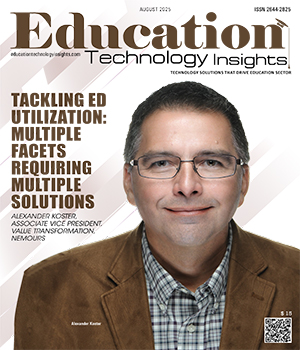THANK YOU FOR SUBSCRIBING
Be first to read the latest tech news, Industry Leader's Insights, and CIO interviews of medium and large enterprises exclusively from Education Technology Insights
Reframing Social and Emotional Learning: From Reservations to Renewal
Jacquelyn Ollison, Ed.D. Director, Center for Research on Expanding Educational Opportunity (CREEO), University of California, Berkeley
 Jacquelyn Ollison, Ed.D. Director, Center for Research on Expanding Educational Opportunity (CREEO), University of California, Berkeley
Jacquelyn Ollison, Ed.D. Director, Center for Research on Expanding Educational Opportunity (CREEO), University of California, BerkeleyFor many years, I held reservations about Social and Emotional Learning (SEL). As an educator working with children of color, I resisted frameworks that suggested my students lacked grit or resilience. Of course, they had grit. The lived realities of navigating systemic inequities demanded perseverance. To claim otherwise felt deficit-based. My stance was and still is that our job as educators is to recognize the assets students already bring into the classroom—not to impose frameworks that focused on what we perceive is missing. Over time, however, my understanding of SEL shifted. I came to see it more as a set of practices that help both children and adults navigate their emotions in healthy, constructive ways. Today, I view SEL as essential not only for students but also for teachers, administrators and communities.
Defining SEL
The Collaborative for Academic, Social and Emotional Learning (CASEL, 2017) defines SEL as the process through which children and adults acquire and apply the knowledge, attitudes and skills necessary to understand and manage emotions, set and achieve positive goals, feel and show empathy, establish and maintain positive relationships and make responsible decisions. These competencies—selfawareness, self-management, social awareness, relationship skills and responsible decision-making—are not innate deficits to be filled but developmental assets that can be intentionally nurtured.
From Student SEL to Adult SEL
My earlier hesitation also stemmed from the lack of clarity around what SEL looked like for adults. Teachers were expected to model emotional regulation and empathy, but how could they do so without support for their own well-being? Research confirms that teacher well-being directly affects student well-being and achievement (Beard et al., 2021). During the COVID-19 pandemic, teachers were thrust into the role of “first responders” to student trauma, often without parallel supports for their own social and emotional health.
This imbalance echoes my own research on compassion fatigue, which found that educators in urban schools often face burnout and secondary trauma without adequate institutional support (Ollison, 2018, 2024). Without attention to adult SEL, schools risk creating environments where students’ needs are named but teachers’ needs are ignored—leading to high turnover, instability and diminished learning opportunities.
SEL and Equity
SEL must be grounded in equity. California’s School Conditions and Climate Work Group Report emphasizes that fostering SEL requires schools to create inclusive environments where identity is affirmed, student voice is valued and families are engaged as partners (California Department of Education [CDE], 2017). This aligns with the call for SEL practices that support students of color and avoid placing the burden of adaptation solely on them (Beard et al., 2021).
SEL and School Climate
The School Conditions and Climate Work Group Report underscores that SEL thrives in environments where safety, connection and belonging are prioritized (CDE, 2017). Research links positive climates to improved academic performance, stronger social-emotional development and better teacher retention (Thapa et al., 2013). My book, Addressing Compassion Fatigue in Urban Schools: Strategies for Sowing Seeds of Resilience, highlights how educator wellness is inseparable from student success (Ollison, 2024). Schools that foster climates of care for both adults and children are more likely to see gains in engagement, achievement and retention.
A Call for Collective SEL
Today, I believe SEL should be something all teachers know and understand, not an optional add-on but part of the profession’s core. Implementation must be consistent across classrooms to ensure equity of access. Educators must learn to navigate their emotions in healthy ways, both to model this for students and to sustain themselves in a demanding profession.
As Beard et al. (2021) remind us, teacher well-being is foundational for student well-being. And as my own work has shown, without addressing compassion fatigue, schools risk losing talented educators when students need them most (Ollison, 2018, 2024). Social and Emotional Learning, when understood not as a deficit but as a strength-based practice, has the potential to transform school climates. It affirms the assets students already bring, provides tools for navigating emotions and creates communities where both children and adults can thrive.
Read Also
Navigating the Grey: A New Framework for AI in Higher Education
Irreplaceable: Schools that Prepare Future-Ready Learners
Inspiring Futures Through Access and Opportunity
Reframing Social and Emotional Learning: From Reservations to Renewal
Innovative Leadership in Professional Learning Programs
Balancing Technology and People in a Dynamic School System

I agree We use cookies on this website to enhance your user experience. By clicking any link on this page you are giving your consent for us to set cookies. More info

However, if you would like to share the information in this article, you may use the link below:
www.educationtechnologyinsightseurope.com/cxoinsights/jacquelyn-ollison-nid-3521.html




















